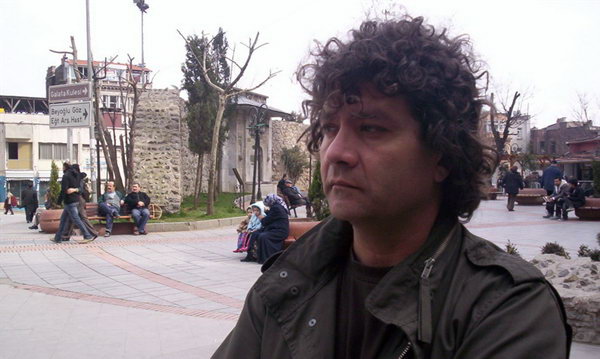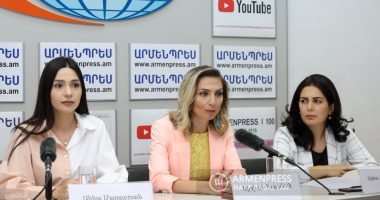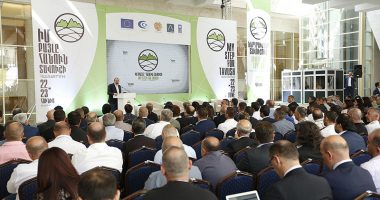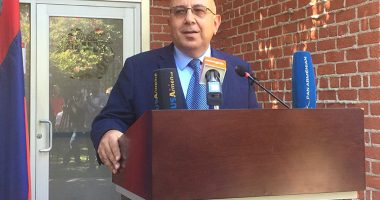By Dr. Mary A. Papazian
Mary A. Papazian, Ph.D., president of Southern Connecticut State University, addressed The United Nations Association of Connecticut (UNACONN) in Kent, Conn., on April 25, 2015, on the occasion of the Centennial Commemoration of the Armenian Genocide.
The United Nations Association of Connecticut (commonly abbreviated as UNACONN or UNA-CT) is the official Connecticut state chapter of the United Nations Association – United States of America. It is a nonprofit membership organization dedicated to building understanding of and support for the ideals and vital work of the United Nations among American people. The association is affiliated with the World Federation of United Nations Associations, which was established in 1946 as a public movement for the UN.
The text of President Papazian’s speech follows:
Some years ago, my husband Dr. Dennis Papazian, a longtime Professor of History at the University of Michigan, Dearborn, wrote an article that he first delivered at a symposium in Vienna, Austria entitled “Genocide, the Curse of the Nation-state.” He reminded his audience that in the Peace of Westphalia of 1648, which ended the vicious religious wars in Europe, it was decided that each state would practice Christianity according to the orientation of its ruler, whether he/she was Protestant or Roman Catholic, as decided at the earlier Peace of Augsburg (1555) which established the principle cuius regio, eius religio, [as the prince, so the religion.]
This concept—that the religion of the ruler be the religion of the state, with no authority above the state to which anyone might appeal—was to award the state ultimate sovereignty or dominion over its inhabitants. Thus, what the state did to its inhabitants was nobody’s business. At Westphalia, sovereignty was deemed to reside in the “sovereign,” or the ruler, the chief authority over all things domestic as well as foreign affairs. The concept of “imperial rule,” central rule over many states (e.g., the Holy Roman Empire, the Ottoman Empire and British Empire later), was downgraded and eventually abandoned after World War I.
As the states of Europe slowly democratized in the 19th century, to one extent or another, in theory at least, the sovereignty belonged to the people. But in reality, this sovereignty was exercised by the government that might or might not respond to the desires of the population. In any case, although Westphalia presumed and demanded conformity to the religious orientation of the ruler, life was not that simple. Most of the states of Europe continued to have minorities of different ethnic and religious origins who in the treaties were guaranteed very limited rights, chiefly the right to practice their religious in private. Nevertheless, since there was no way to guarantee these limited rights, what the sovereign ultimately did with these minorities was nobody’s business. Thus, the principles developed at Westphalia, especially those relating to respecting the boundaries of sovereign states and non-interference in their domestic affairs, became central to the World Order that developed over the following centuries and which remains in effect to this day!
Raphael Lemkin, a Polish-Jewish lawyer, coined the word “genocide” using the Armenian case is an example. It was not just a question of coining a word, however, which had been done many times in history and was usually of little or no consequence. But the word “genocide” reflected a whole new idea of dealing with sovereignty by, at least in theory, limiting the power of the sovereign over human beings. It is just this reality that we hope someday will shape international relations. In other words, the concept of genocide as defined by Lemkin had the potential to create a new World Order in which national minorities are guaranteed their lives by the international community.
Much of the discussion around the Armenian Genocide centers on whether the “G-word” should be used to describe the events of 1915-1923. So why is the word genocide so important, and why did Raphael Lemkin coin the word in the
first place? And why did he enshrine it in a treaty that he spent his life trying to have adopted by the United Nations?
Raphael Lemkin was born in Poland in 1900 and at a very young age was instilled with a sense of justice by well-educated and pious family. He was a serious teenager, growing up just at the time when the Ottoman Empire was slaughtering its Armenian subjects in 1915-1916. By 1921 Lemkin had entered the University and was particularly enamored of international law, which at that time was established by treaties between two states or among a group of states, there being no permanent superior authority.
It was in that very same year, 1921, when a young Armenian by the name of Soghomon (Solomon) Tehlirian assassinated Mehmet Talaat Pasha, who as Minister of the Interior and later Grand Vizier was one of the chief masterminds of the Armenian genocide. After Turkey surrendered in the Mudros Armistice of October 30,1919, Talaat Pasha had been whisked away to safety by the German Navy. Talaat Pasha had been living comfortably in Berlin, with his wife and friends, when Tehlirian tracked him down and assassinated him in broad daylight on one of the main German boulevards.
Tehlirian made no attempt to escape. Rather, he told the gathering crowd over and over again, “He and I are foreigners, and this has nothing to do with Germany.” Tehlirian was arrested, sent to jail, and put on trial. At the trial he testified that he was haunted by his mother’s spirit, his mother who had been beheaded in front of him, and who appeared in his dreams and demanded vengeance. Of course the Germans at that time were well aware of the vast and horrible murders that had been and were continuing to be committed against the Armenians all over Anatolia and northern Syria. Amazingly, Tehlirian was acquitted for not being responsible for his actions. This may have been the first time in history that a murderer was set free because he was not responsible, mentally and morally, for his actions.
Lemkin, who was following these events, asked the question: “Why is the killing of an individual a crime, punishable by law, and the killing of millions by their government was no crime at all?” The Allied Powers had confronted the same problem after the war and accused of the Ottoman Government, the Young Turk dictatorship, of crimes against “humanity and civilization, a new concept.” Thus the annihilation of the Armenians became an “international issue,” not just an Armenian issue. It was under this rubric that war crime trials were held in Malta by the British government, trials that were abandoned at the time Mustafa Kemal Ataturk was in rebellion overthrowing the Sultan’s government.
Interestingly, the Turkish government also held little-known but very important war crime trials, a series of courts-martial, and convicted the Young Turk leadership, including Talaat and others, condemning them to death. So, in a sense, Tehlirian was carrying out the punishment prescribed by the Turkish courts-martial since, since the guilty had fled to other countries. The Turkish leaders were accused of war crimes, since there was no domestic Ottoman law against genocide.
Lemkin decided that what the world needed was an international law against the killing of racial, religious, or ethnic minorities by their own government; namely, to limit the sovereignty of individual states when it came to dealing with large numbers of domestic inhabitants. He spent the rest of his life working for an international agreement against genocide, a word he devised to express this newly understood crime, a crime that had been called by Winston Churchill as “the crime without a name.” Henceforth, the killing of one man would be murder and the killing of a nation would be genocide. That is why it is so important apply the word genocide to the Armenian massacres of 1915-1923, since it brings those events under international law where Lemkin thought it should be. Words do matter.
In this context, how should we understand the challenge of “a journey beyond hate,” the topic of this panel? It would be inhuman if those who had experienced the mass slaughter of Armenians, namely the survivors, most of whom were children from age 6 to 16, and whose lives were mangled almost beyond repair, did not hate those who drove them from their homes, and who they witnessed torturing and killing their mothers, fathers, sisters, brothers, aunts and uncles, grandmothers and grandfathers, cousins and friends. Not to hate under those circumstances would be absolutely unnatural, actually inhuman, neurotic, without feeling. One must hate extreme evil when one is a witness and a victim.
As my husband often says: “They are dead, the victims and the killers, they are all dead. There is no one left to hate. Their fate is in God’s hands.”
We also understand, in a very profound sense, that to bring health to society we need to hate the crime and love the criminal. Of course when it comes to torture and murder, this becomes a bit difficult. How many of you could watch a child being crucified, and then hate the crime and love the criminal? How many of you could watch a three-year-old child being used by horsemen as a ball in a game of polo, and then hate the crime and love the criminal? Thank God, we are not faced with that choice today. The victims and the killers are all dead.
We must also understand, that some of the victims themselves, the survivors, carried hatred in their hearts for those who killed and tortured their relatives and friends, although they rarely spoke about these horrific events. It was not until approximately 50 years after the Armenian Genocide that the survivors were willing to tell their stories.
But we, today, are the children, grandchildren, and great-grandchildren of the survivors. We did not personally experience being driven out of our homes and sent on death marches. We did not witness torture and murder. It is easier for us to step back and take a larger view. As we said, the victims and the perpetrators are all dead. What is left is us and the progeny of the killers.
Armenians living today, despite the adverse publicity on the part of a few individuals who project their own feelings on others, are ready to reconcile with the Turkish people. Of course, that presumes there is someone with whom to reconcile! Reconciliation must go both ways. It is a two-way street. It has been well noted that denial is the last stage of genocide, for to erase memory, is to complete a genocide.
The act of forgiveness would be much easier if the progeny of the killers recognize the guilt of their predecessors and disowned those horrible events. In such a case, the progeny of the killers and the progeny of those murdered could come together and shed tears partaking in each other’s grief. Those who killed and were killed are all dead, and there are a few survivors alive today.
I am happy to report that that recognition is indeed happening today in many parts of Turkey and here in the United States. The present generation of Turkish intellectuals is more inclined to take a serious look at the past of their country and to accept the realities of the past, thus freeing themselves from the burden of denial and opening themselves to reconciliation and renewal of their own country.
My husband and I for the last 15 years or so have invited Turkish students and scholars into our home so that we could recognize each other as people and not as objects. Of course in the early days most of these Turks were deniers of the Armenian genocide—decent and good people, but not at all knowledgeable. But in more recent times, as they have learned and studied and opened their minds and hearts, they have become acknowledgers.
It is heartwarming to watch the transformation of open-minded Turks from deniers to acknowledgers as they study the wealth of evidence that has been accumulated by international scholars, initially Armenians, and now by numerous objective European and Turkish scholars.
In matter of fact, the most learned all of these Turkish scholars is Dr. Taner Akcam, who has accumulated much archival evidence from those Turkish archives which are open and with whom my husband worked a decade ago to gather the materials on the Turkish war crime trials.
The most recent books by Taner Akcam, published both in Turkish and in English, have convinced people of good faith, with archival evidence, that the Turkish government of that time did intend to commit a genocide against its Armenian Christian minority, as well as Greek and Syriac Christians. The wholesale slaughter of Armenians is what the American ambassador in the Ottoman Empire, Henry Morgenthau, called the “murder of a nation” and “racial extermination.”
Thus, I can happily report that most Armenians today have moved beyond hatred to objective analysis and realistic attempts to bridge the gap between Turks and Armenians, both in Turkey, in America and in Armenia. But this is not a fairytale world, and the goodness that we can imagine or desire is not always realistic. You have to deal with real people and with real situations. Still, progress is being made.
This past summer our family went on a trip to Anatolia, present-day Turkey, to visit sites where Armenians had lived for thousands of years and from which they were driven during the genocide. One of the people whom we met was the former Mayor of the old city of Diyarbakir, Abdullah Demirbas. Diyarbakir, which effectively is the capital of Turkish Kurdistan, was a city inhabited by Armenians from ancient times. Apparently, there are perhaps only a few hundred part-Armenians alive today, all titular Muslims, who are beginning to admit to and study the origins of their families.
Our small group met with Mayor Demirbas who spent almost an hour with us in a cavernous room inside of the vast walls of the city. He told us that he had built the first Armenian Genocide Monument in Turkey, and that he had the identification written in five languages, including Turkish and English, so that all could read and understand.
He said that he wanted to apologize for the horrible crimes committed by the Kurds against the Armenians, and he explained how he was dedicating his life to the rectification of this crime. It was he who led the way towards the major repairs on the local Armenian Church, Sourp Giragos, so that it could be used once more for worship.
Of course those interested in bringing the Armenian genocide to a proper closure welcome the declaration of Pope Francis, the European Parliament, and the German Reichstag, the German president and the German Chancellor, who have recently announced their recognition of the vast Armenian massacres as Genocide, joining other countries such as France. We also welcome remarks by the American Jewish Committee reaffirming the Armenian Genocide and urging the President to put the United States on record as acknowledging the Armenian killings as genocide.
We have been disappointed by President Erdogan of Turkey who has made nasty comments against the Pope and the European Parliament as well as the Armenians. But we applaud the hundreds if not thousands of Turks who commemorate, in Turkey, the Armenian Genocide and who seek reconciliation.
Too often the question to Armenians is why do you demand that people use the term “genocide?” Those who are neither Armenians nor Turks would do well to stress confession and recognition on the part of Turks and Turkey rather than pressuring the Armenians to betray the past. Yes, we have moved beyond hate, but we cannot abandon rationality. One can demand justice without hate. It’s done every day in America’s courts of law. Pressure should be put on the criminal and not the victim. We must not condone genocide by ignoring it.
And so, one hundred years after the Medz Yeghern, the “Great Crime” in Armenian, it is time to move beyond hate. But that can only be accomplished by an honest, truthful reckoning with the past—in Turkey most importantly—but throughout the world, as the reverberations of this “crime against humanity” — the Armenian Genocide — continues to impact us all.
Genocide is repeated over and over again because the perpetrators believe they will not be held accountable. That is the wrong lesson to teach the evil of this world.











1 comment
It’s not just a matter of Turkey’s acknowledging the Armenian genocide.
Turkey destroyed not just people but a culture and homes, farms, churches, and took a trillion dollars from the Armenian people.
There are reparations and much more to be paid. The criminal must not be allowed to profit from his crime.